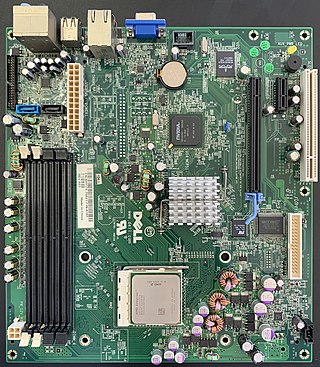
Computer engineering is a branch of computer science and electronic engineering that integrates several fields of computer science and electronic engineering required to develop computer hardware and software. Computer engineering is referred to as computer science and engineering or Electrical and Computer engineering at some universities

Gerald Jay Sussman is the Panasonic Professor of Electrical Engineering at the Massachusetts Institute of Technology (MIT). He has been involved in artificial intelligence (AI) research at MIT since 1964. His research has centered on understanding the problem-solving strategies used by scientists and engineers, with the goals of automating parts of the process and formalizing it to provide more effective methods of science and engineering education. Sussman has also worked in computer languages, in computer architecture, and in Very Large Scale Integration (VLSI) design.
Neuromorphic computing is an approach to computing that is inspired by the structure and function of the human brain. A neuromorphic computer/chip is any device that uses physical artificial neurons to do computations. In recent times, the term neuromorphic has been used to describe analog, digital, mixed-mode analog/digital VLSI, and software systems that implement models of neural systems. Recent advances have even discovered ways to mimic the human nervous system through liquid solutions of chemical systems.
The expression computational intelligence (CI) usually refers to the ability of a computer to learn a specific task from data or experimental observation. Even though it is commonly considered a synonym of soft computing, there is still no commonly accepted definition of computational intelligence.
This is an alphabetical list of articles pertaining specifically to software engineering.

Jacek M. Zurada is a Polish-American computer scientist who serves as a Professor of Electrical and Computer Engineering Department at the University of Louisville, Kentucky. His M.S. and Ph.D. degrees are from Politechnika Gdaṅska ranked as #1 among Polish universities of technology. He has held visiting appointments at Swiss Federal Institute of Technology, Zurich, Princeton, Northeastern, Auburn, and at overseas universities in Australia, Chile, China, France, Germany, Hong Kong, Italy, Japan, Poland, Singapore, Spain, and South Africa. He is a Life Fellow of IEEE and a Fellow of International Neural Networks Society and Doctor Honoris Causa of Czestochowa Institute of Technology, Poland.
David B. Fogel is a pioneer in evolutionary computation.

Michelle Anne Mahowald was an American computational neuroscientist in the emerging field of neuromorphic engineering. In 1996 she was inducted into the Women in Technology International Hall of Fame for her development of the Silicon Eye and other computational systems. She died by suicide at age 33.

Robert Jackson Marks II is an American electrical engineer, computer scientist and Distinguished Professor at Baylor University. His contributions include the Zhao-Atlas-Marks (ZAM) time-frequency distribution in the field of signal processing, the Cheung–Marks theorem in Shannon sampling theory and the Papoulis-Marks-Cheung (PMC) approach in multidimensional sampling. He was instrumental in the defining of the field of computational intelligence and co-edited the first book using computational intelligence in the title. A Christian and an old earth creationist, he is a subject of the 2008 pro-intelligent design motion picture, Expelled: No Intelligence Allowed.
Eric L. Schwartz was Professor of Cognitive and Neural Systems, Professor of Electrical and Computer Engineering, and Professor of Anatomy and Neurobiology at Boston University. Previously, he was Associate Professor of Psychiatry at New York University Medical Center and Associate Professor of Computer Science at the Courant Institute of Mathematical Sciences at New York University.
Russell C. Eberhart, an American electrical engineer, best known as the co-developer of particle swarm optimization concept. He is professor of Electrical and Computer Engineering and adjunct professor of Biomedical Engineering at the Purdue School of Engineering and Technology, Indiana University Purdue University Indianapolis (IUPUI). He is a Fellow of the IEEE and a Fellow of the American Institute for Medical and Biological Engineering.
Informatics is the study of computational systems. According to the ACM Europe Council and Informatics Europe, informatics is synonymous with computer science and computing as a profession, in which the central notion is transformation of information. In some cases, the term "informatics" may also be used with different meanings, e.g. in the context of social computing, or in context of library science.
George V. Cybenko is the Dorothy and Walter Gramm Professor of Engineering at Dartmouth and a fellow of the IEEE and SIAM.
Philip H. Newcomb is an American software engineer and CEO of The Software Revolution, Inc., known for his work in the field of formal methods of software engineering.
This glossary of artificial intelligence is a list of definitions of terms and concepts relevant to the study of artificial intelligence, its sub-disciplines, and related fields. Related glossaries include Glossary of computer science, Glossary of robotics, and Glossary of machine vision.
Optimization Systems Associates (OSA) was founded by John Bandler in 1983. OSA produced the first commercial implementation of space mapping optimization to enhance the speed and accuracy of engineering design. OSA’s primary thrust was in computer-aided design (CAD) and simulation and optimization of radio-frequency and microwave circuits and systems. Its products included developments of Bandler's space mapping concept and methodology, which facilitates effective modeling and design optimization of computationally intensive engineering systems.
Jianchang (JC) Mao is a Chinese-American computer scientist and Vice President, Google Assistant Engineering at Google. His research spans artificial intelligence, machine learning, computational advertising, data mining, and information retrieval. He was named a Fellow of the Institute of Electrical and Electronics Engineers (IEEE) in 2012 for his contributions to pattern recognition, search, content analysis, and computational advertising.

Lyle Norman Long is an academic, and computational scientist. He is a Professor Emeritus of Computational Science, Mathematics, and Engineering at The Pennsylvania State University, and is most known for developing algorithms and software for mathematical models, including neural networks, and robotics. His research has been focused in the fields of computational science, computational neuroscience, cognitive robotics, parallel computing, and software engineering.






